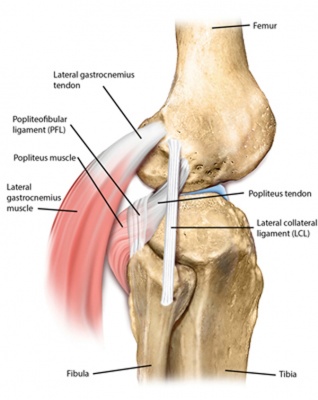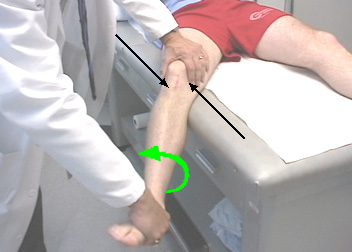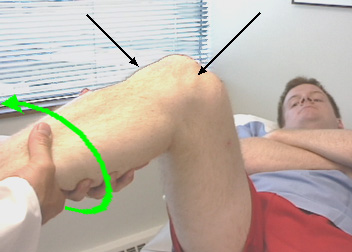Dial Test
Original Editors - Gaëlle Vertriest as part of the Vrije Universiteit Brussel's Evidence-based Practice project
Top Contributors - Tomer Yona, Gaëlle Vertriest, Rachael Lowe, Admin, Kim Jackson, Yvonne Yap, Daphne Jackson, Uchechukwu Chukwuemeka, Tony Lowe, Kai A. Sigel, WikiSysop and Wanda van NiekerkPurpose Cite error: Invalid <ref> tag; name cannot be a simple integer. Use a descriptive title[edit | edit source]
The purpose of the Dial Test is to diagnose posterolateral instability and to differentiate between isolated PLC injury and combination PLC/PCL injury [1].
The test can be clinically valuable when:
1. Three posterolateral structures (Popliteus tendon, Popliteofibular ligament, Lateral collateral ligament) are injured.
2. There is combined injury to the PCL and two other posterolateral structures.
Its important to know that when only one or two structures are injured , the dial test is not enough to diagnose the injury. For an isolated PCL tear, the posterior drawer test or sag tests are more relevant.
Clinically Relevant Anatomy[edit | edit source]
Relevant structure of the posterolateral corner in the knee [2]
Technique
[edit | edit source]
The test can be done with the patient either in prone or supine position (Different authors prefer different positions[1] [3])
The goal of test is to inspect the external rotation (foot-thigh angle, best measured in a clinical setting [4])at the knee joint while the knees are in 30° and 90° of flexion .
Patient in prone position :
The clinician flexs the patient knees to 30° and places both hands on the feet of the patient, cupping his heels. A maximal external rotation force is then applied, and the foot-thigh angle is measured and compared with the other side. The knees are then flexed to 90°, and again an external rotation force is applied and the foot-thigh angle is measured again [1].
If the clinician choose to do the test while the patient is in supine position, there are two possible positions:
1) Same as in prone position - the knees are held together and bent to 30°, the clinician turns the lower legs and feet outwards and compares the amount of external rotation of the tibial tubercle. Repeat the test with the knees at 90°.
2) The knee is flexed over the side of the bed. The clinician stabilized the thigh and apply an external rotation force through the foot and ankle. Then, the clinician looks for the amount of external rotation of the tibial tubercle, and compare it with the other knee [3].
Evaluation[edit | edit source]
The test is positive when there is more than 10° of external rotation in the injured knee compared to the uninjured knee.
There are two types of different injuries :
- An isolated injury to the PLC - more than 10° of external rotation in the injured knee is present at 30° of flexion, but not at 90° of flexion.
- Instability of the PCL: more than 10° of external rotation in the injured knee is present at 90° of flexion, but not at 30° of flexion.
- A combined injury: more than 10° of external rotation in the injured knee is present at 30° and 90° of flexion. This is an injury of the PCL and the PLC. [3][1]
Because of the difficulty in measuring the external rotation angle, Magee describes the following method of evaluation in his book [5] : If the tibia rotates less at 90° than at 30°, an isolated posterolateral (popliteus corner) injury is more likely. If the knee rotates more at 90°, injury to both the popliteus corner and posterior cruciate ligament is more likely.
References[edit | edit source]
- ↑ 1.0 1.1 1.2 1.3 Lubowitz JH, Bernardini BJ, Reid JB. Current Concepts Review Comprehensive Physical Examination for Instability of the Knee. The American journal of sports medicine. 2008 Mar 1;36(3):577-94.
- ↑ Noyes FR. Noyes' knee disorders: surgery, rehabilitation, clinical outcomes. Elsevier Health Sciences; 2009 Aug 20.
- ↑ 3.0 3.1 3.2 LaPrade RF, Wentorf F. Diagnosis and treatment of posterolateral knee injuries. Clinical Orthopaedics and related research. 2002 Sep 1;402:110-21.
- ↑ Krause DA, Levy BA, Shah JP, Stuart MJ, Hollman JH, Dahm DL. Reliability of the dial test using a handheld inclinometer. Knee Surgery, Sports Traumatology, Arthroscopy. 2013 May 1;21(5):1011-6.
- ↑ Magee DJ. Orthopedic physical assessment. Elsevier Health Sciences; 2014 Mar 25.









